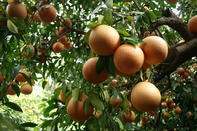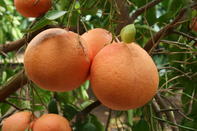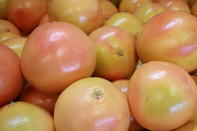Grapefruit is a hybrid that developed out of a spontaneous cross between the pummelo (also spelt as pomelo) and sweet orange. As a relatively new addition to the citrus family, grapefruit was first described in the 1750s by the Reverend Griffith Hughes on the island of

Barbados. He also called it the “forbidden fruit” of Barbados, as some people believed it had some kind of link with the original tree of good and evil of the Garden of Eden.
The name “grapefruit” was chosen, because of the way the fruit grew in grapelike clusters. American horticulturists initially wanted to call the species “Pomelo”, but the name change caused confusion with the “Pummelo” so “grapefruit” stuck.
International Grapefruit Production
Grapefruit thrives in warm subtropical climates. As reflected by Tridge, China is the biggest producer. In 2018, grapefruit production accounted for roughly half of all the grapefruit produced in the world. The United States, which is the second-largest producer, only accounted for 8% of the total production.
Despite achieving a mere 4% of the total production, South Africa grapefruit production accounted for 25% of all grapefruit exports in 2018. This makes it the biggest grapefruit exporter by far. China took the second position, at 12.7% of all exports.
The Netherlands is the main exporter of grapefruit, with 16.6% of all imported grapefruit (this grapefruit is imported from other countries in order to be repackaged and exported). It should nevertheless be remembered that the Netherlands often redistribute its imports to other parts of Europe. Russia follows the Netherlands at 10% of all grapefruit imports.
South African Grapefruit Production

In 2018, South Africa, together with Zimbabwe, had a total of 7 886 ha registered for grapefruit exports, as presented by the Citrus Growers Association. More than 50% of this area was situated in Limpopo, making it the largest export producing region, followed by Mpumalanga, which accounted for 20% of the production area.
KwaZulu-Natal took third place, with 9% of production. Whereas the Northern Cape and Swaziland respectively accounted for 6% and 5% of the total area registered for exports. Small areas are also registered in the Eastern and Western Cape. Zimbabwe accounted for 118 ha of the total area registered for exports.
Grapefruit Varieties

Many varieties are planted, of which Star Ruby and Marsh are the most popular. Star Ruby accounted for over 80% of the total area registered for exports in 2018. Whereas Marsh took second place, with a little more than 10% of this area.
Star Ruby was developed by Dr Dick Hensz in Texas through irradiated Hudson grapefruit seed. This variety was named and released in the 1970s, with the first twelve seeds making its way to South Africa in 1972.
The fruit has a smooth yellow skin with a red background and deep red-coloured flesh. The variety performs much better in South Africa than in the United States, producing large fruit with rarely more than a couple of pips.
Marsh was introduced by CM Marsh in Florida around the 1860s from a chance seedling from a Duncan tree on a property of a Mrs Rushing. He took budwood for propagation from one of the trees, when he saw that it was seedless and started selling the budded offspring. The fruit is large and white, seedless and primarily used for fresh consumption and juicing. For a long time, it was the leading cultivar planted in South Africa.
Grapefruit Season
The citrus season in South Africa stretches from March to July, depending on the variety and climatic conditions.
Grapefruit Markets
Most of South Africa’s grapefruit are sold overseas, with the export market accounting for almost 70% of all sales in 2017. The processed market accounted for roughly 27% and the local market for less than 1% of the total sales.
Europe is the biggest export destination, with 40% of the volumes in 2017, whereas Asia accounted for 25% of the volumes.
Uses of Grapefruit

Grapefruit is a bitter-tasting fruit. It can be enjoyed fresh for breakfast, as a snack, or used in salads. It is also processed into tarts, jellies, marmalade, and beverages.
It is one of the lowest-calorie fruit, yet rich in nutrients and fibre, which is one of the reasons why it is often included in weight-reducing diets. It also has a high water content, making it very hydrating.
For bulk or Grapefruit export enquiries please use the enquiry link below.